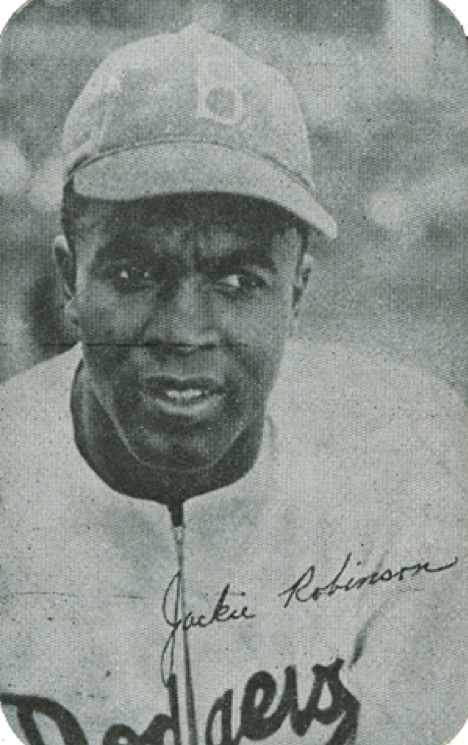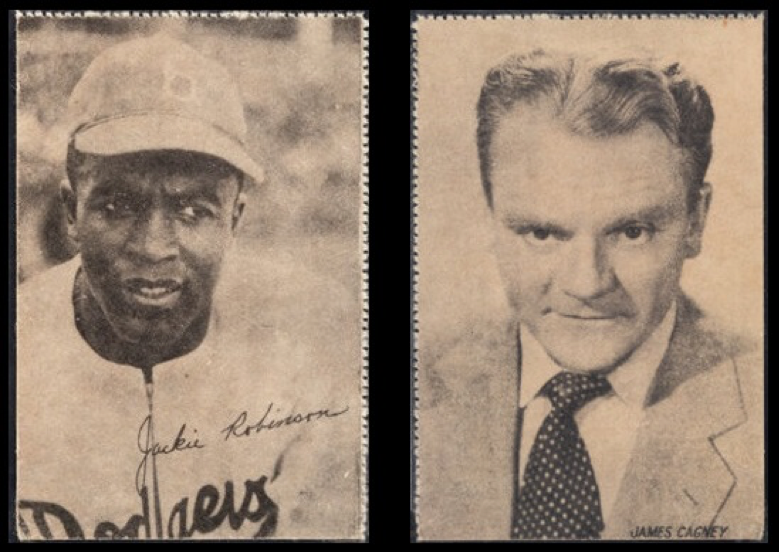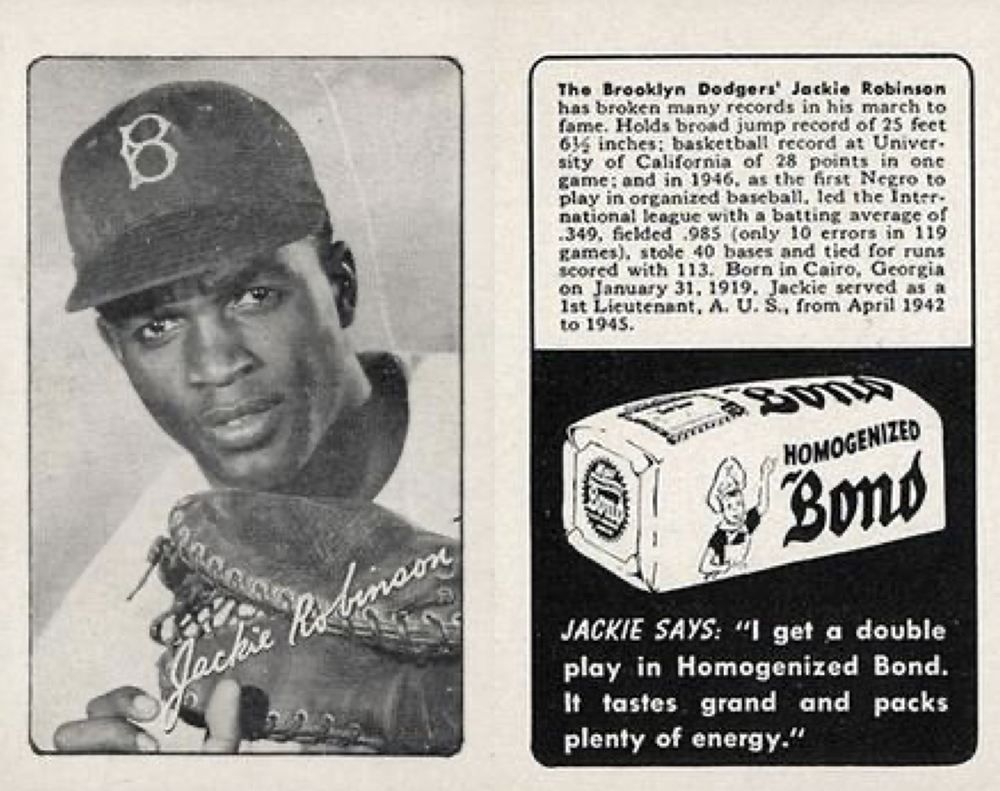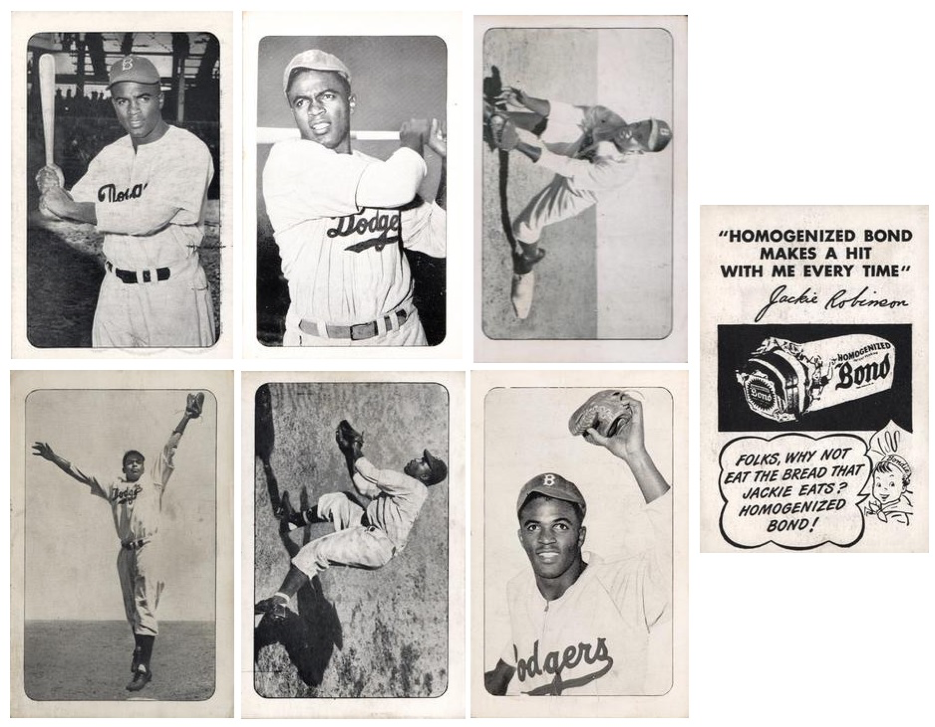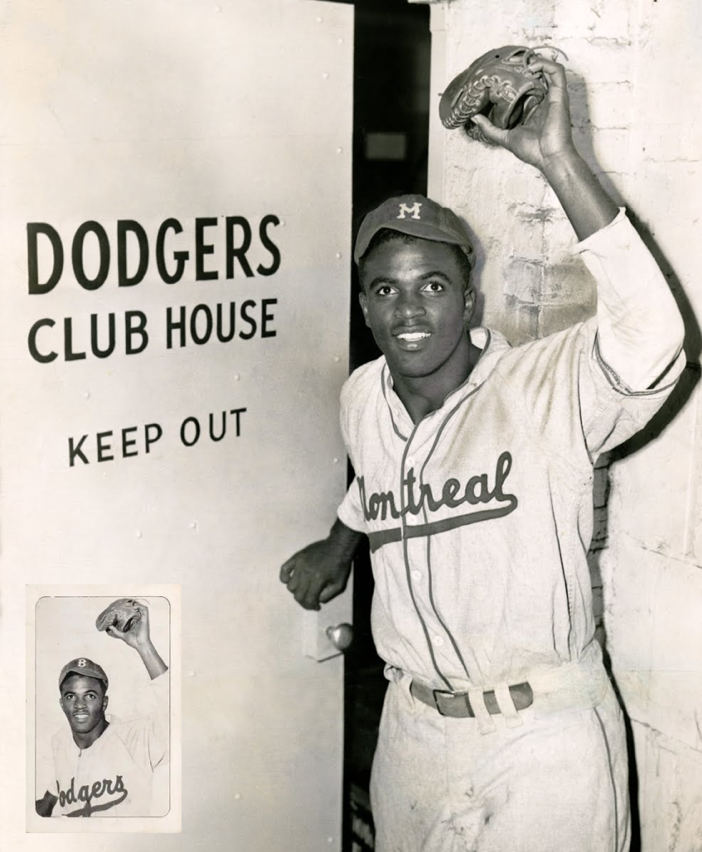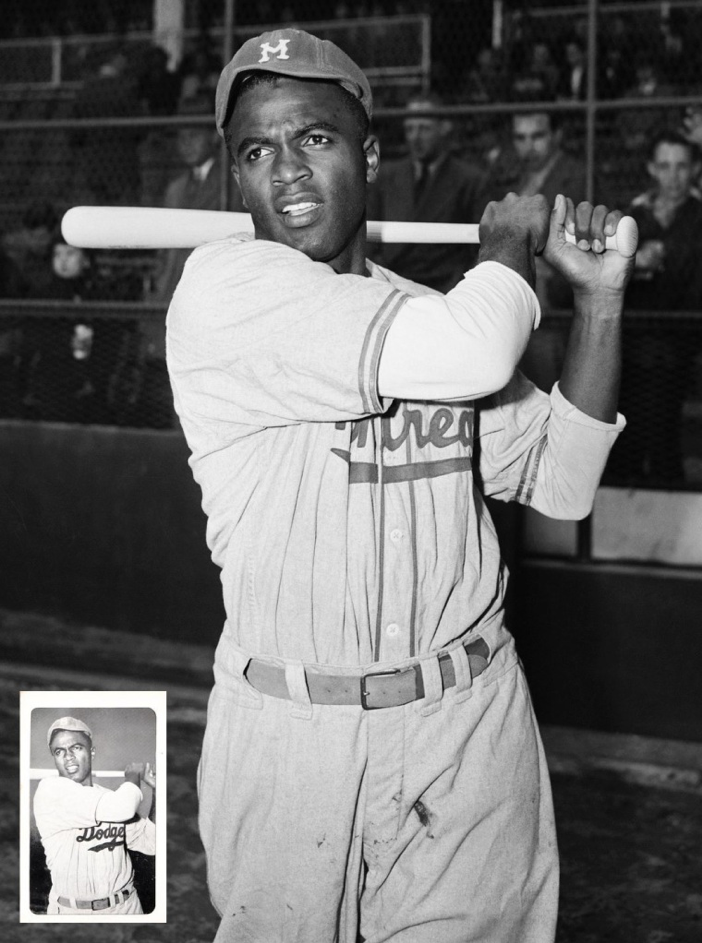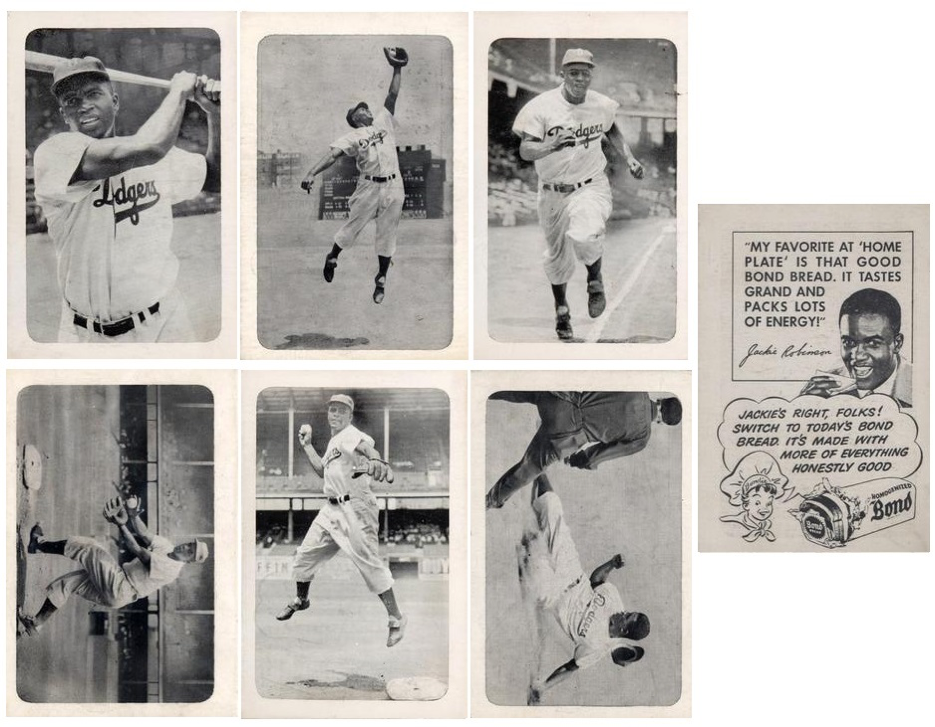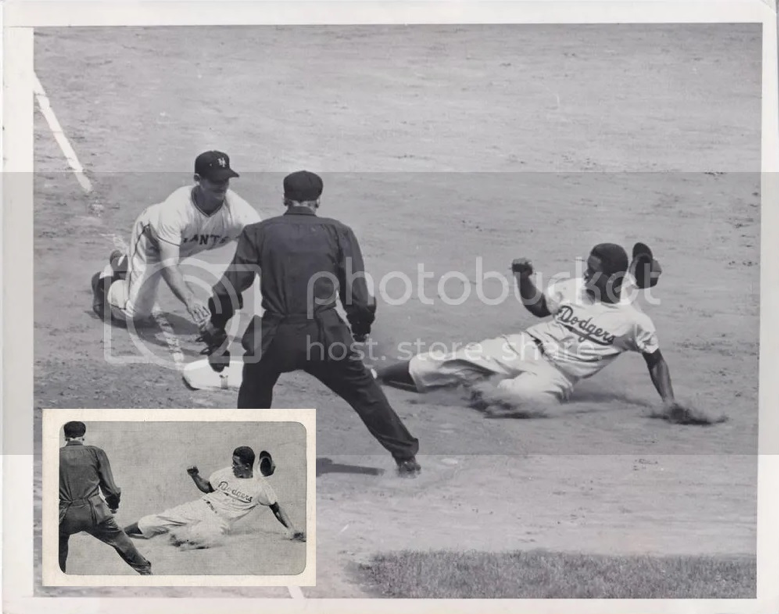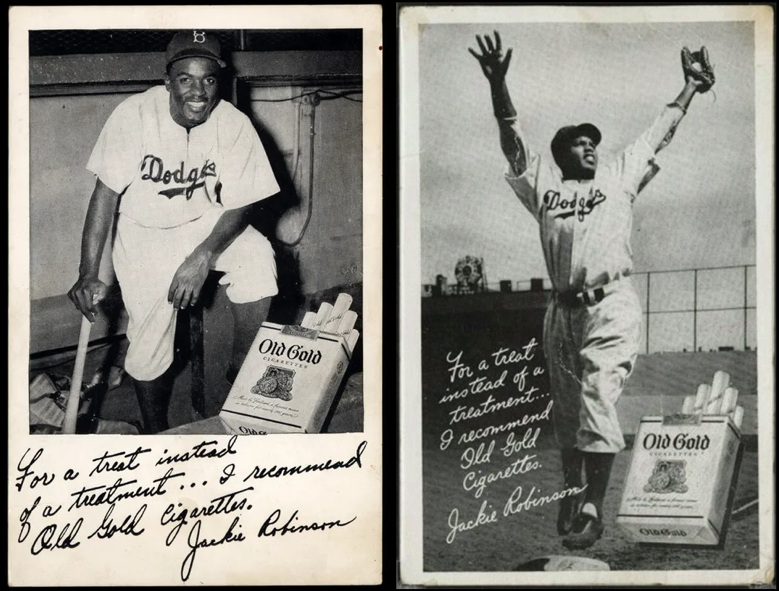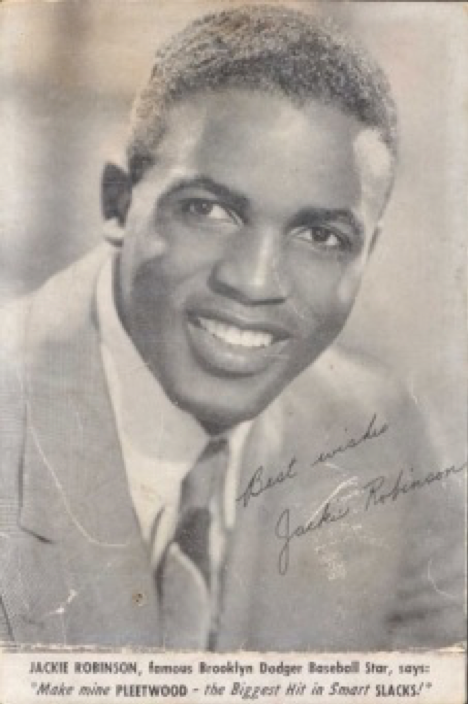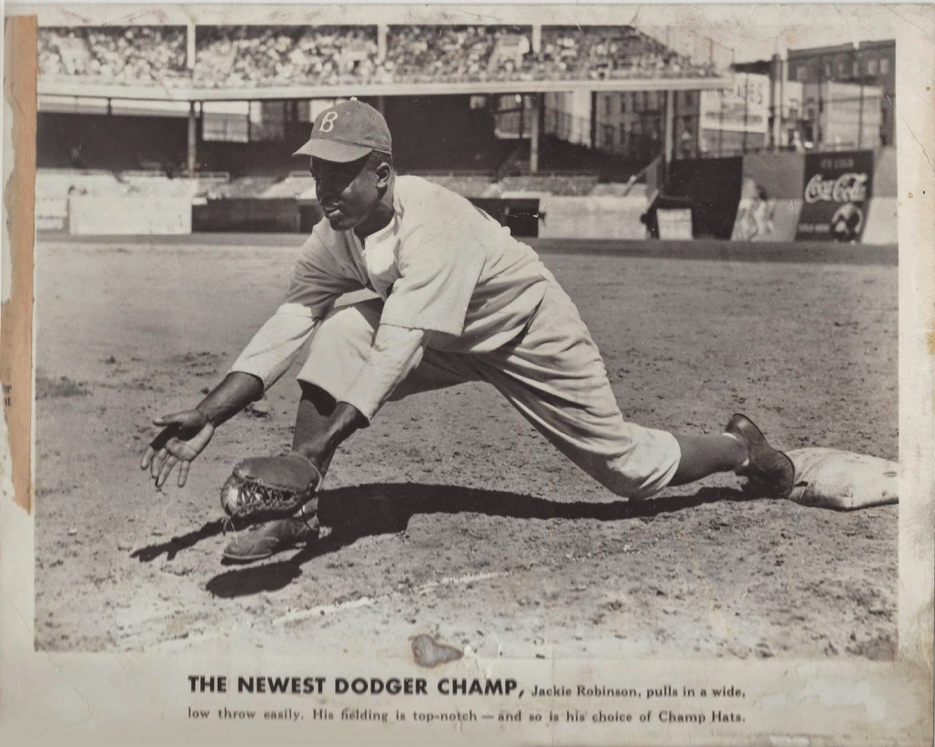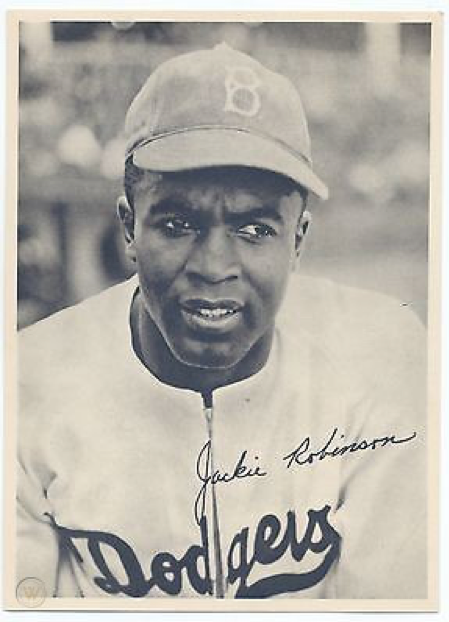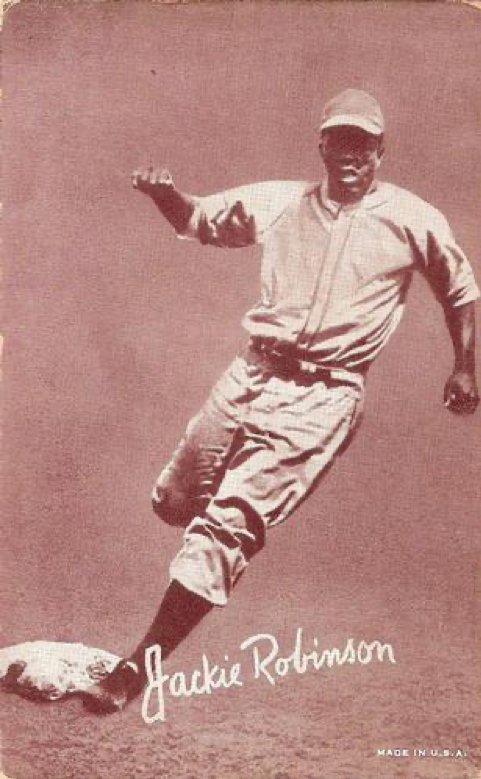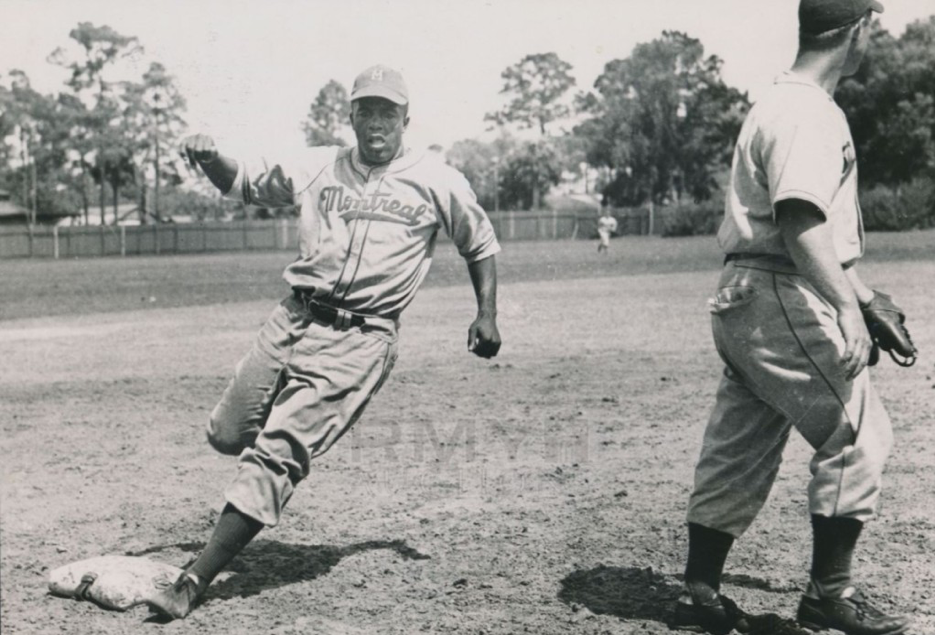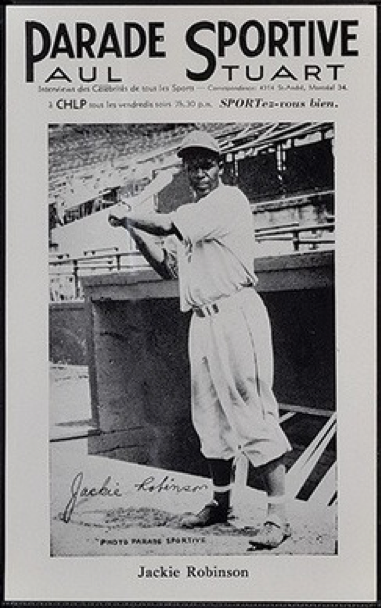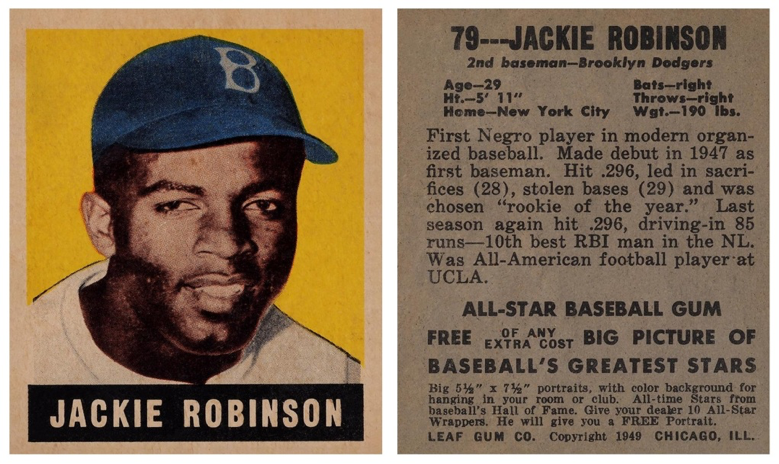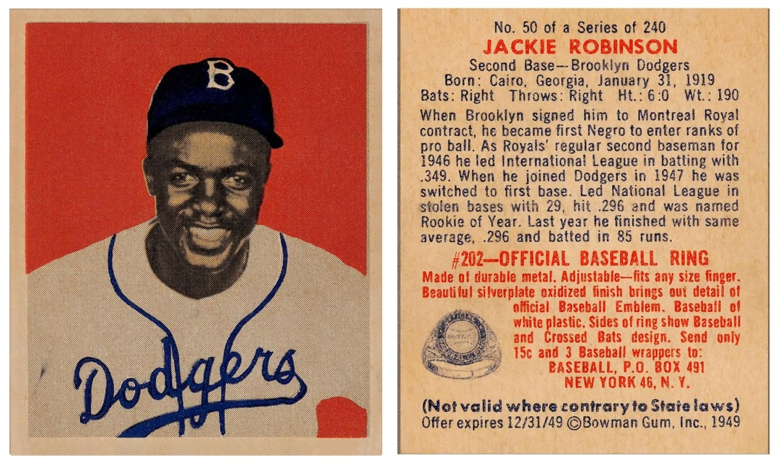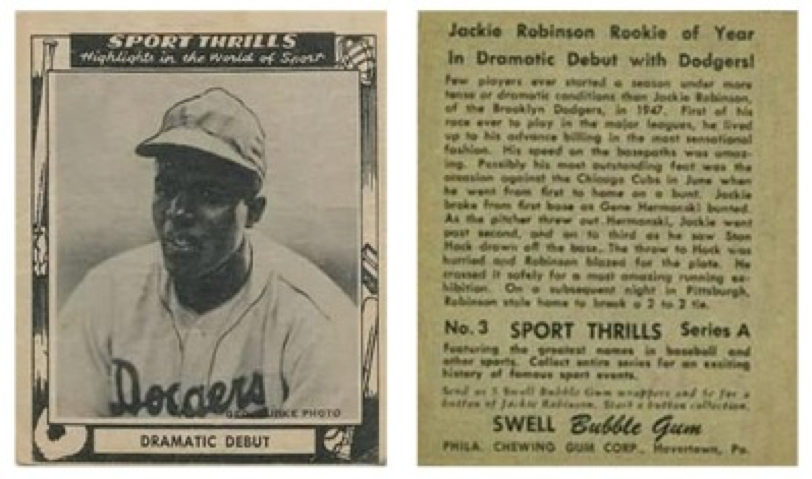42 in ’47: The Baseball Cards of Jackie Robinson’s Dodger Debut
Editor’s note: This article was originally published in 2022 as part of SABR’s Jackie Robinson 75th Anniversary Project.
When Jackie Robinson trotted out to first base on April 15, 1947, his steps were no less historic than those of Neil Armstrong just over two decades later. Baseball’s senseless and shameful color barrier had at last been breached and with it the customs and traditions of Jim Crow America itself were on notice. This is not to say equality had come to Baseball. Far from it as even the Dodgers merely tiptoed into integration while several other teams waited a decade or more to add their first Black player. As for managers, eleven more men after Armstrong would walk the moon before a single Black man would take the reins of a major league team.
Even today, as Jackie’s legacy is rightfully celebrated, it’s fair to wonder whether a modern Jackie Robinson would even choose Baseball, just as it’s fair to wonder whether any teams would notice him and sign him if he did. Were he living in the Dominican Republic, absolutely, but in his birthplace of Cairo, Georgia, or his childhood hometown of Pasadena, California, who’s to say? While a modern Jackie could win games for a general manager of any color, there are none in front offices today who look like him.
The same could be said for domestic baseball card issues prior to 1947, only one of which featured a Black player. While it would be easy to discount the utter lack of Black faces as merely reflective of the times, such an explanation fails to account for the many Black boxers who made their way onto trading cards, going back to at least 1909. Ultimately, the whiteness of baseball cards was due solely to the whiteness of what was then perceived (and enforced) as Organized Baseball. Jack Johnson, Joe Jeannette, and Joe Gans were professional boxers. The Philadelphia Stars, Newark Eagles and Homestead Grays meanwhile? These were semi-pro.
Thus the 1947 season brought with it not only the integration of Baseball but (several rungs down the ladder of importance) the opportunity to integrate baseball cards as well. All that was missing were the baseball cards themselves!
While today we take it for granted that a new baseball card set (if not dozens of different ones) will come out every year, such was not the case in the 1940s. Following the three-year run of Gum, Inc., and its Play Ball sets from 1939-41, the War and other national priorities left American baseball without a major set to chronicle its players until 1948, when Gum, Inc., baseball cards returned to shelves, this time under the Bowman name.
In the meantime, where baseball cards were produced at all, they most often took the form of smaller regional issues, often connected to food or other household products, cards that today many collectors classify under the umbrella of “oddball.” As such, this review of 1947 Jackie Robinson baseball cards from 1947 will feature bread, slacks, and even cigarettes but not a single stick of gum.
1947 BOND BREAD
Bond Bread will feature in this article twice. This first instance is to highlight a 48-card release comprised of four boxers and 44 baseball stars. The selection of baseball stars included Ted Williams, Joe DiMaggio, and Stan Musial but most notably a baseball card of Brooklyn Dodgers rookie Jackie Robinson.
Cards were packaged in loaves of Bond Bread, and at least one theory for their rounded corners is that the cards were less susceptible to damage that way. Importantly for collectors today, the rounded corners help distinguish these cards from near-identical versions that emerged as a standalone product sold as “Sport Star Subjects” in 1949. The square cornered versions are far less collectible, though widespread misidentification, including by a prominent grading company, has created sufficient confusion to elevate prices among uninformed buyers.
While both the Bond Bread and Sport Star Subjects cards have blank backs, a third version of the Robinson card features a back that’s anything but blank.
“1947” ELGEE PRODUCTS
Precise dating for this issue is unknown and may well be after 1947. A mix of baseball and movie star photos, the baseball images match those of the Bond Bread issue but are easily distinguished in at least two ways. One, they are perforated. Two, their backs include other cards from the set or, in some cases, advertising. The Robinson card, for example, features actor James Cagney on the reverse.
As with the Sport Star Subjects, these cards are also frequently misidentified as Bond Bread cards, even by third party grading companies and auction houses. Post 391 in this Net54 Baseball Forum thread shows the front and back of an uncut sheet, including the ELGEE branding. Post 386 in the same thread provides additional background on the company.
1947-50 BOND BREAD JACKIE ROBINSON
In addition to the 48-card set above, Bond Bread also released a second set of 13 cards dedicated entirely to Jackie Robinson. The set is catalogued as a 1947 issue. However, independent research by collectors Mike Knapp, Shaun Fyffe, and Michael Fried, which I’ll attempt to summarize here, has produced a broader timetable for the cards while also providing information on distribution.
The set began in 1947 with a single card featuring a signed portrait of Jackie, a brief bio, and a product testimonial. This card was not distributed in packaged loaves but rather was given out by store owners (with free slices of bread!) to promote Bond Bread among African American consumers. (Post 49 in this Net54 Baseball Forum thread includes an article from the New York Amsterdam News detailing the marketing strategy.)
From there, it’s unclear whether any of the set’s remaining twelve cards dates to 1947. The aforementioned collector-researchers speculate subsequent releases of three or six cards at a time taking place sometime between 1947 and 1950, though I lean more toward the cards being issued one at a time. Either way, a clue that helps group the cards is the advertising on the back.
These six cards, assumed to be the earlier of the twelve, exhort consumers to eat the same bread as Jackie. Fielding poses show a first baseman’s mitt, which Jackie would have used primarily in 1947.
Before proceeding to the second group of six, I want to highlight two photos in particular, one of which may be very familiar to non-collectors. Though the background has been removed and Jackie has even changed teams, the card of Jackie waving with his glove draws its image from this iconic photograph.
A second card among the six does some early “photoshopping” of a Montreal photo as well.
Much later in this article we will see yet another occasion where a Montreal photo is doctored for use on a Brooklyn card. For now, we will return to the other six cards in the set. Note here that all fielding poses show a standard infielder’s glove.
The “smoking gun” that places these cards (or at least one of them) after 1947 comes from the image on the last card, believed to source to a photograph taken just after this one. (Note Jackie’s cap has fallen a bit farther on the card and his body has separated more from his trailing arm.) If so, the card could not have been issued any earlier than July 2, 1949, the date the photograph was taken.
With the set no longer confined entirely to 1947, we arrive at several possibilities for its overall release schedule. Barring further information, I’d be inclined to settle on the first group of six cards coming out across the six months of the 1948 baseball season and the second group of six following suit in 1949.
Whatever the precise release schedule, I do think most collectors treat the entire set as if it came out in 1947, conferring coveted rookie card status on any of the thirteen cards they’re lucky enough to possess.
“1948” OLD GOLD CIGARETTES
The situation with Jackie’s Old Gold cards is precisely the opposite as here collectors regard what may be two cards from 1947 as if they came out the following year.
As Anson Whaley notes in his article for Sports Collectors Daily, two clues on the card backs are more suggestive of a pre-1948 release.
- Robinson is listed as 28 year old, which was only his age through January 30, 1948
- His 1947 Rookie of the Year Award (announced September 19, 1947) is not listed among his career highlights
Certainly each of these clues could merely point to bios written ahead of time, hence do not point definitively to a 1947 release of the actual cards. Still, absent any information affirming a 1948 release, the clues are certainly intriguing.
“1947″ PLEETWOOD SLACKS
Continuing the theme of uncertain dates is this rare 5″ x 8″ promotional issue from Pleetwood Slacks. While catalogued as a 1947 issue, I am unable to find any source that provides independent corroboration. Notably, the Standard Catalog of Vintage Baseball Cards indicates that “the [1947] date of issue cited is conjectural.”
When I do find “hits” on Pleetwood Slacks, never mind Jackie, they only come in the Black press of late 1948, specifically October through December. Here is the copy they bring up, with only minor variation from paper to paper.
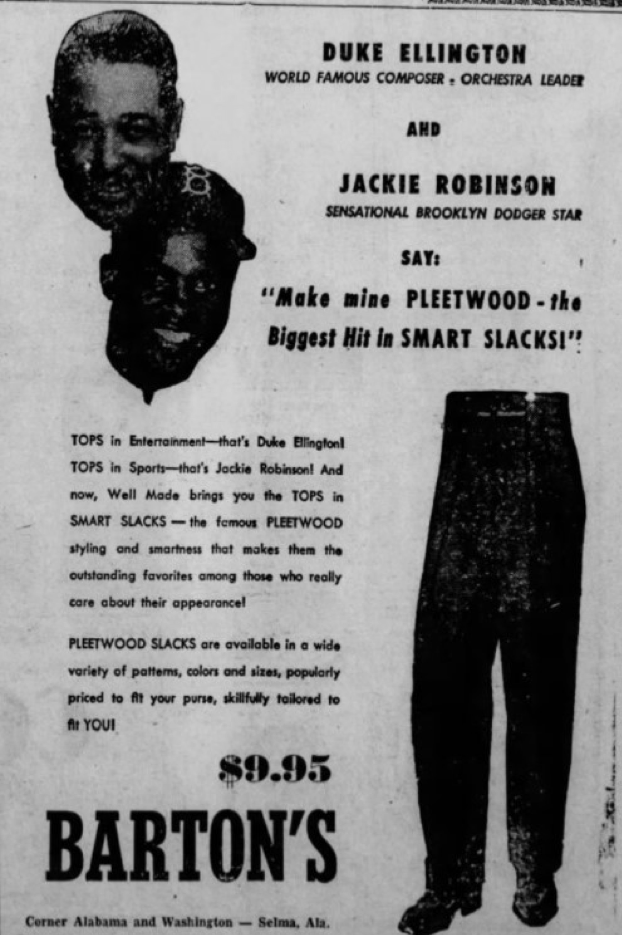
Alabama Citizen, December 18, 1948
Perhaps information is out there somewhere establishing the Pleetwood Slacks card as a 1947 issue. In the meantime I’d just as soon date it to late 1948 where timing would better match the print advertising campaign.
1947 CHAMP HATS
Collector and Hobby historian Bob Lemke (1941-2017) featured this 8 x 10 “card” as a new find on his blog in 2015.
As detailed on Bob’s blog, both Bob and the previously mentioned Sean Fyffe regarded 1947 as the most likely year for this piece.
1947 DODGERS TEAM PHOTO PACK
Many teams sold photo packs of their players and other personnel, going back to at least the 1930s. The 1947 Brooklyn Dodgers photo pack consisted of 25 photos, 6 x 9 in size, including this one of Jackie Robinson.
The image is a sharper and cleaner version of the ones used on his Bond and faux Bond issues and a reminder that many cards of the era used photos provided by the teams or their photographers. Furthermore, the presence and identical placement of Jackie’s signature on the Bond and pseudo-Bond cards leads me to wonder if those cards didn’t originate from the original photograph but from this photo pack card. Either way, I suspect the photo pack Jackie is the earliest of his various 1947 issues.
1947-66 EXHIBIT SUPPLY COMPANY
One of the most common and (formerly!) affordable early baseball cards of Jackie Robinson is his 1947-66 Exhibit Supply Company (Chicago, IL) postcard-sized issue. However, despite “1947” right there in the naming of the set, there is no evidence that Jackie’s exhibit cards date back that far.
Rather, the “1947-66” label simply means that the overall set of 300+ different cards spanned 20 years. The presence of later stars such as Aaron, Banks, and Kaline suffice to show that “1947” hardly applies to all players.
The Keyman Collectibles site provides a guide for the precise dating of Exhibit cards. Having reviewed more than a dozen so far, I have not yet run across a Robinson any earlier than 1948.
Side note: A 1948 release would have left plenty of time to find pictures of Jackie as a Dodger. However, the photograph used on the Exhibit card, as was the case with two of the Bond Bread cards, dates to 1946, as evidenced by Jackie’s Montreal uniform.
SUMMARY: THE JACKIE ROBINSON CARDS OF 1947
All told I’ve reviewed 22 different Jackie Robinson cards correctly or incorrectly associated with his barrier-breaking debut season in Brooklyn. From this number, there are only three where I believe the 1947 dating is firmly established:
- 1947 Bond Bread multi-player set
- 1947 Bond Bread Jackie Robinson set – portrait with facsimile autograph
- 1947 Brooklyn Dodgers photo pack
For the reader only reasonably acquainted with the world of collectibles, it might seem a tame question to then ask which of these cards is Jackie Robinson’s rookie card. Could it really be that the answer is none of them!
EPILOGUE: JACKIE’S ROOKIE CARD
Modern collectors focus heavily (if not obsessively!) over the notion of a rookie card, particularly when the player concerned is a Hall of Famer. In a simpler world, a player would have one card for each year of his career, and the first such card would be his rookie card. In the real world, however, the situation is far murkier, complicated by any number of wrinkles, depending on the collector.
For example, any of the following may be treated as a disqualifying when it comes to rookie card status.
- cards that pre-date a player’s major league status (e.g., a minor league card)
- cards from minor, regional, unlicensed, or non-US releases
- cards that aren’t really baseball cards (e.g., a postcard, mini-poster, or bobblehead)
- cards with uncertain release dates
In the case of Jackie Robinson, all four of these come into play. While I did not feature it in this article due to its 1946 issue date, there is a highly sought after Parade Sportive newspaper insert featuring Jackie Robinson, which checks off each of the first three bullets above.
As for Jackie’s Bond Bread cards, many collectors regard the releases as too minor to warrant rookie card status. Add to that for many of them an uncertain release date as well. Ditto for Elgee Products, Old Gold Cigarettes, Pleetwood Slacks, and Champs Hats, with the latter two having only questionable baseball card status as well.
The Brooklyn photo pack card, which may well be first of Jackie as a Dodger, also challenges the most rigid definitions of “baseball card” while also carrying the potential disqualifier of a regional release. Finally, the Exhibit card may or may not meet all definitions of baseball card but carries uncertainty as to dating.
Also lacking card status to most collectors are the various Jackie Robinson buttons and pins that were popular among fans in the late 1940s. I omitted lengthier treatment in this article but will show six of them here.
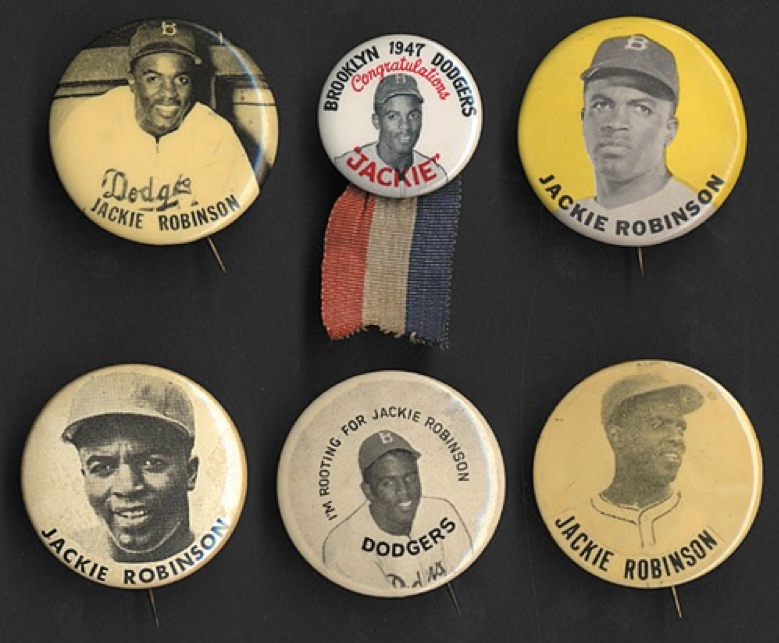
Source: Robert Edward Auctions
The result of all this is that many collectors would not consider any of the Jackie Robinson cards profiled so far to be Jackie’s rookie card. Instead, the coveted label is most often applied to Jackie’s card from the set known popularly in the Hobby as 1948 Leaf.
“This is the only true rookie card of baseball’s first African-American representative and hero to all,” according to PSA, the Hobby’s largest grader and authenticator of trading cards.
Though my revenue, Hobby or otherwise, is a far cry from that of PSA, I will nonetheless challenge the assertion. For one thing, despite the typical designation of the set as “1948 Leaf” (or sometimes 1948-49 Leaf), there are strong reasons to believe the Robinson card (if not the entire set) dates to 1949.
- 1949 copyright date on the back of the card
- Reference to Jackie’s 1948 statistics as “last season” on the back of the card
- Standard Catalog entry indicating the set was “produced by Chicago’s Leaf Gum Co. for issue in 1949.”
Dubious dating aside, I’ll also note that the Leaf cards, at least of some players, were unlicensed, which can often be a rookie card disqualifier. That said, collectors tend to give the set a free pass on this point.
At any rate, if we regard the Leaf card as a rookie card, we should then confer rookie status on Jackie’s other significant release of the same year, issued as part of the 1949 Bowman set of 240 cards.
Alternatively, we might turn our attention to a card that genuinely does date to 1948, Jackie’s Sport Thrills card from Swell Bubble Gum.
From a rookie card perspective, this card beats Leaf and Bowman by a year, has unambiguous baseball card status as opposed to some of the other 1947-48 contenders, and comes from the least minor release of its contemporaries and predecessors. At the same time, not all collectors treat the Sport Thrills set as a major release, and the set equally loses some pedigree as one focusing more on highlights than individual players.
Ultimately, the question of Jackie’s true rookie card is a complicated one, confounded by the uncertain or erroneous dating of his early cardboard and curiously subjective notions like “major” and “baseball card.” On one hand, the lack of a definitive rookie card opens the door for individual collectors to apply their own criteria and judgment. On the other hand, the same fuzziness creates opportunities, intentional or accidental, to misrepresent and misinform. In the end, perhaps the only truism when it comes to Jackie’s rookie cards is this: If you have to ask, you can’t afford it!
JASON SCHWARTZ is co-chair of SABR’s Baseball Cards Research Committee. Find more baseball card stories at sabrbaseballcards.blog or on Twitter @SABRbbcards.




